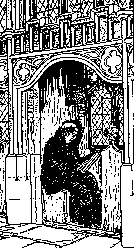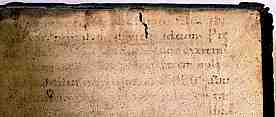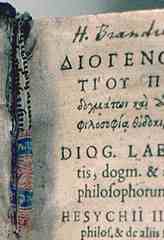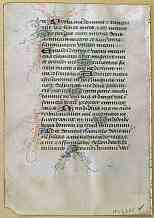 |
| Where
to Find Manuscripts |
| It
is a common belief that medieval manuscripts
are rare. They are not. There are hundreds upon thousands of them out
there, although many times more have been lost than have been preserved.
Being small, portable, and actually quite robust under the right circumstances,
they are undoubtedly the most widely dispersed and easily located category
of artifact from the medieval era. Many have travelled far from their
places of origin through the agency of private collectors. |
| The
trouble is, they are also the most difficult of items to make accessible,
and so people tend to not know that they are there. They can be damaged by
excessive light, by changes to temperature and humidity, by the sweat from
sticky fingers and by rough treatment of their bindings. In a “hands off” situation it is only possible to see one page at a time. To study manuscripts
properly, it is necessary to be formally introduced to their keepers. |
 |
The
story of the survival of manuscripts is a social history in itself. For
centuries the monasteries of Europe curated and enlarged their libraries,
only to have them destroyed or dispersed in a sudden social upheaval;
a reformation here, a revolution there. Aristocratic collectors or local
institutions scrabbled together what they could to form the nuclei for
the great accumulating bodies of the 19th and 20th centuries; the huge
museum libraries. Places like the British
Library in London, the Bibliothèque
Nationale in Paris or the Vatican
Library in Rome hold vast repositories of these dispersed and regathered
collections. |
| Many
manuscript books floated around the world in the baggage of private collectors,
turning up in American libraries or universities, gracious homes on all continents
or even public libraries. Art museums have also collected them. Universities
have collections great or small. There is an interesting variation in attitude to manuscript books, some being regarded essentially as art works and housed accordingly, while others, less lavishly produced, are valued for their text. This may affect not only where they are to be found, but the attitude to access to the original by scholars. If you want to do a detailed textual analysis involving much handling of the original, it might be best to choose something scruffy. |
| Unfortunately
the attitude to preservation of these artifacts has been through a few
changes along the way. The cutting up of books to remove miniatures
or historiated
initials, or even to make up scrapbooks of decorated alphabets, was
not uncommon. Some very famous manuscripts books have some significant
holes in them. Today single leaves from ancient books circulate around
the antiquities market, aided by the ease of trade in these things over the internet. Some of these are the relics of old books pillaged in the past for their art work, while in other cases books are still being dismantled. While there are probably enough literary scholars out there to watch out for books with unique texts, there seems to be less value placed on the integrity of works such as Bibles, breviaries or books of hours, which are perceived to have standardised texts of less interest to scholars, and which already exist in many copies. Every book dismantled represents a loss, but every fragment salvaged is an authentic little piece of the past, so we have a conundrum here. |
|
| |
An
isolated sheet from a late 15th century French book of hours, by permission
of the University of Tasmania Library. |
| Parchment
or vellum, from which
many manuscript leaves were made, is an expensive but durable and useful material.
Even in the middle ages it was re-used by scraping down and writing over,
forming palimpsests.
Old leaves have also been used in bookbindings as covers or pastedowns,
this use extending into the era of printed books. Sheets of manuscripts have
been used as wrappers for other documents. So fragmentary bits of old documents
sometimes appear in the most unusual places. Some of the oldest manuscript
fragments known are in this form. |
 |
A
sheet of parchment with 12th century writing has been used as a pastedown
in a 15th century volume of the works of Cicero, by permission of the University
of Tasmania Library. |
 |
 |
Some
further fragments include a narrow strip from a psalter which has been used
in a bookbinding, and a strip from a Dutch language book of hours sewn into
the binding of a late 16th century printed book. By permission of the University
of Tasmania Library. |
 |
 |
| Both sides of a tiny fragment of a German notarial document of the 15th or 16th century found inside a book, from a private collection. |
| The above example represents not only a fragmentary find of a medieval manusript, but also something of the changing valuation of written material over the centuries. This little piece of a legal document certified by a notary, part of whose distinguishing mark can be seen on the upper left of the right hand picture, was found by a bookseller, along with a number of other fragments, in an incunabula copy of the Biblical commentaries of Nicholas de Lyra. Four strips were found to have come from a single document, and the fragments had evidently been cut into strips for use either as binding strengtheners or bookmarks, or for some other reason. Presumably when it was done, possibly hundreds of years ago, these documents were regarded as in no way valuable. Now we would regard them as historical evidence. Another theory, romantic but perhaps unlikely, is that the documents were cut up and placed in an obscure tome in order to hide them for some reason. So you just never know when a little piece of medievalia is going to pop out at you. |
| This all leads to the fact that not all medieval manuscripts are books. There are also vast collections of original documents of a legal nature out there, and these are also widely dispersed around public and private places. |
|
|
 |
 |
 |
 |
 |
 |






